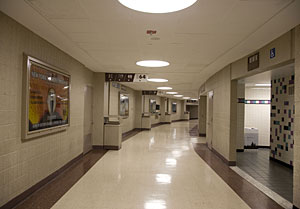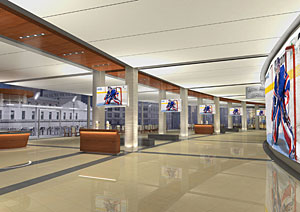“There has been nothing to signal a transformation in the sea of blight and abandonment that still defines much of” New Orleans, The New York Times reported on April 1, one year after municipal officials unveiled the city’s rebuilding plan. Created by Edward Blakely, who led the successful recovery of Oakland, California, after that city suffered both an earthquake and fires during the 1990s, the New Orleans plan targeted 17 recovery zones. “On their one-year anniversary, the designated ‘zones’ have hardly budged,” the Times wrote. As residents seek explanations, they are blaming Blakely—who they criticize for spending too much time at his other job, in Australia, teaching urban planning—Mayor Ray Nagin, who is said to be barely visible, and the federal government, which has been slow to release promised funds for rebuilding. Thus, while demolition of damaged structures has been ongoing, little is rising to replace them. A more serious problem is that the city has begun bulldozing a group of undamaged public housing complexes at a time when residents desperately need affordable options. Blakely, for his part, points to the successes so far, which he admits are “still light stuff. I think people were expecting they’d wake up one morning and it would be nirvana. But little things are happening, cleanups, fixups, and so on.” But as the Times noted, “Growing frustration points up what has been a recurring theme in New Orleans’s sketchy, on-again, off-again recovery from Hurricane Katrina: grandiose official promises, apparently made to lift the public’s morale, that soon prove unrealistic.”
![]()
Listen to a podcast of these headlines and more.
Click the play button to begin | Click here to download


Images courtesy Madison Square Garden
The interior concourse of Madison Square Garden as it currently appears (top), and a rendering of how it might appear after renovations by Brisbin Brook Beynon (above).
Renderings of a renovated Madison Square Garden were unveiled yesterday, one week after the arena’s owners, the Dolan family, backed out of plans to move the event venue and rebuild New York City’s Penn Station. The New York Times reported on April 4 that the $500 million rehabilitation scheme, designed by the Canadian firm Brisbin Brook Beynon, includes “the creation of a sunlit entryway off Seventh Avenue, the installation of luxury suites closer to the floor and better views of the action, even from the last row of seats.” One of the nation’s the oldest professional hockey and basketball facilities, the exiting Garden was built during the 1960s on the site of McKim, Mead & White’s original Penn Station; the rail hub now occupies a basement concourse below it. Efforts to rebuild the station in a post office building across the street, designed by the same storied architects, have progressed by fits and starts since the 1990s; they all but collapsed during the past month. While leaving most of the exterior unchanged, Brisbin Brook Beynon’s refurbished Garden would “double the ceiling height of the entrance off Seventh Avenue, near 33rd Street, and install a glass canopy over the hall leading to the ticket windows. In addition, there would be an upper-level party deck where patrons could mingle while viewing a game.” The Dolans’ decision to stay put could jeopardize funding for plans to rebuild Penn Station in the post office, but developers involved in that effort as well as city officials “insist that they have not scuttled the plan, known as the Moynihan project, as a result of the Garden’s announcement,” the Times wrote.
British Airways is predicting that all normally scheduled flights will begin operating tomorrow out of its new Heathrow Terminal 5, according to an April 3 article on Forbes.com. Since the $8.6 billion terminal opened on March 27, more than 400 flights were cancelled and tens of thousands of bags went undelivered; estimates ranged from 14,000 to 28,000 pieces of luggage separated from passengers, a backlog that could take weeks to clear. As RECORD reported just before the opening of T5 (as the building is known), the Rogers, Stirk, Harbour & Partners design included high-tech baggage handling systems and expanded check-in areas to reduce passenger queues. The BBC, reporting on March 31, chronicled opening day failures that began with a lack of sufficient employee parking and workers’ unfamiliarity with the new space, causing many to be late to work; delays in getting workers through security checkpoints; and an overall lack of sufficient staffing. As bags from the landside portion of the terminal began entering the delivery system at a rate of 12,000 per hour, too few handlers were ready to collect them on the airside, resulting in a pile-up, flight delays, and flight cancellations. British Airways, which operates T5 exclusively, is shouldering blame for the failures—and the financial sting, estimated to cost $32 million, according to an April 4 article in the UK’s Times newspaper. While no one is blaming Richard Rogers’s architecture for last week’s chaos, the situation hasn’t helped his reputation. As a commentator in the UK’s Observer newspaper wrote on March 29: “Some people have praised Richard Rogers’ design, with its sense of scale and space, the use of natural light, the vast steel arches and back-painted glass. But who really cares? There is not a shred of glamour or excitement in an oversized shed in the back end of Southall, even if you can shop at Paul Smith and get a meal cooked (as if) by Gordon Ramsay. We go to airports reluctantly. We leave them with heart-felt relief.”

Post a comment to this article
Report Abusive Comment